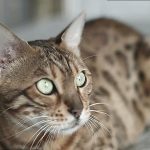Are you a cat lover who enjoys watching videos of feline intelligence? Well, hold on to your whiskers because we’re about to explore the opposite end of the spectrum. Yes, you guessed it. Some cat breeds are just not that bright. But don’t worry, we won’t judge them too harshly. After all, they still make adorable companions.
In this blog post, we’ll dive into which cat breeds are considered the stupidest. Now, before you get your claws out, let us clarify that every breed has its unique qualities and intelligence isn’t the only measure of a cat’s worthiness. However, if you’re looking for a smart companion to impress your friends with their problem-solving skills, then these breeds may not be for you.
We’ve done our research and consulted with feline behaviorists to bring you the top 5 cat breeds that are notorious for their lack of intelligence. From their inability to understand basic commands to their knack for getting themselves into trouble – these cats will have you scratching your head in disbelief.
So grab some catnip and join us as we reveal which breeds made the list. Who knows? You might even have one of these “not-so-bright” felines sitting on your lap right now.
What is Intelligence in Cats?
One way to measure cat intelligence is through their adaptability to new situations or environments. Cats have different levels of curiosity and willingness to explore, so some breeds may be more adaptable than others. However, it’s critical to provide cats with a stimulating environment that allows them to exercise their natural instincts and learn new skills.
Another aspect of cat intelligence is their ability to learn and remember. Positive reinforcement techniques such as treats and praise can help cats learn simple tricks or tasks. Furthermore, cats have remarkable memory skills, particularly when it comes to spatial awareness and remembering familiar routes or landmarks.
Communication is another vital component of cat intelligence. They communicate with their owners and other cats through vocalizations, body language, and scent marking. Some breeds may be more vocal or expressive than others while some rely more on nonverbal cues. Understanding your cat’s communication style can help you better communicate with them and strengthen your bond.
Finally, social skills also play a role in cat intelligence. Cats are social animals that require interaction with other cats or humans for optimal mental and emotional health. Some breeds may be more independent or aloof, while others crave attention and affection. Providing your cat with socialization opportunities can help them develop their social skills and improve their overall well-being.
The Persian Cat
Let’s start with their appearance. The Persian cat’s long, luscious coat is undoubtedly one of their most distinctive features. It’s no wonder that many people are drawn to them because of this. But with great beauty comes great responsibility – their long hair requires regular grooming to keep it tangle-free and prevent potential health issues.
Moving on to their personality, while they may not be known as the most intelligent breed, Persians are far from being labeled the “stupidest.” Their calm and gentle nature makes them an excellent choice for families with children or other pets. You can expect them to provide a soothing presence in your home.
It’s essential to note that Persians can be prone to certain health issues due to their short snouts. Respiratory problems and eye infections are relatively common, which is why it’s crucial to keep an eye out for any potential health concerns.
Despite these potential health issues and moderate intelligence levels, the Persian cat remains a beloved and sought-after breed. Their stunning looks and sweet disposition make them wonderful companions for those seeking a furry friend that will bring calm and grace into their lives.
The Siamese Cat
If you’re looking for a feline companion that’s both smart and playful, the Siamese cat is the perfect choice. Originally from Thailand, Siamese cats were highly valued by royalty and monks for their unique appearance and lively personalities. With their striking blue eyes, pointed ears, muzzle, legs, and tail, they are truly a sight to behold.
But what really sets Siamese cats apart is their active minds. They are known for their high energy levels, curiosity, and ability to learn tricks and commands. In fact, Siamese cats are considered one of the most intelligent cat breeds out there. They thrive on mental stimulation and need lots of playtime, toys, and attention to keep them engaged and happy.
Siamese cats are also very vocal and love to interact with their owners through meows and other sounds. They have a knack for communicating their needs and desires, making them great companions for those who enjoy an active lifestyle.
But don’t be fooled by their playful nature – Siamese cats are also very trainable. They can learn a wide range of tricks, from fetching toys to walking on a leash. With patience and positive reinforcement, you can train your Siamese cat to be a well-behaved and obedient pet.
These cats come in a variety of colors, including seal point (dark brown), blue point (gray), chocolate point (light brown), and lilac point (pinkish-gray). No matter what color they are, Siamese cats are sure to turn heads with their stunning looks and lively personalities.
Of course, owning a Siamese cat comes with its own set of responsibilities. These cats require lots of attention and mental stimulation to stay happy and healthy. But with proper care and plenty of love, a Siamese cat can be a loyal and rewarding companion for years to come.
The Himalayan Cat
With their stunning blue eyes and luxurious, fluffy coat, these cats are a sight to behold. But don’t be fooled by their beauty – the Himalayan cat is often considered one of the less intelligent breeds. That being said, they make up for it with their calm and docile personalities, making them loving and loyal companions.
One thing to keep in mind when considering a Himalayan cat is their high-maintenance grooming needs. Their long, fluffy coat requires regular brushing and upkeep to keep them looking their best. Additionally, they may be prone to certain health issues, such as respiratory problems and eye infections. Regular vet check-ups are essential for keeping your Himalayan cat healthy and happy.
While some people may assume that Himalayan cats are not the brightest bulbs in the box due to their breed, this is not always the case. Intelligence levels can vary widely from cat to cat, regardless of breed. Your Himalayan cat may surprise you with their social skills or emotional intelligence.
Factors that Influence a Cat’s Intelligence
It may surprise you to learn that it’s not just genetics – environment and socialization also play a crucial role.
Firstly, genetics can influence a cat’s intelligence. Some breeds, like the Siamese, are known for their intelligence and problem-solving abilities. However, genetics is not the sole determinant of a cat’s intelligence. Factors such as environment and socialization can also have a significant impact.
Secondly, the environment in which a cat is raised can affect their cognitive abilities. Cats who grow up in enriched environments with plenty of toys and opportunities for play tend to be more intelligent than those who don’t. An environment lacking in stimulation can lead to boredom and apathy which negatively impacts a cat’s cognitive abilities.
Lastly, socialization is another factor that can make a difference in a cat’s intelligence. Kittens exposed to different people, animals, and environments during their critical socialization period (between 2-7 weeks of age) tend to be more confident, curious, and adaptable as adults. This exposure helps them develop problem-solving skills, spatial awareness, and other cognitive abilities.
Other Breeds That May Be Considered Less Intelligent
As we all know, cats are incredibly intelligent creatures, but some breeds may be perceived as less intelligent than others based on their unique behaviors and characteristics. Let’s take a closer look at some of these breeds.
First up, we have the Persian. These cats are known for their stunning long hair and affectionate personalities, but they may not be as quick to learn new things or solve problems as other breeds. Some Persians may also be less active and curious than their feline counterparts, which may lead some to perceive them as less intelligent.
Next on our list is the Siamese. These cats are widely recognized for their vocal nature and strong personalities, but they may not be as adaptable to change or as easy to train as some other breeds. Furthermore, some Siamese cats may even develop destructive behavior if they become bored or stressed.
Last but not least, we have the Himalayan. Similar to Persians, these cats are known for their charming personalities and long fur. However, they tend to be less active and curious than other cat breeds and may also be prone to health issues due to their flat faces and shortened noses.
It’s important to remember that intelligence can vary greatly between individual cats, regardless of breed. Just because a particular breed may not excel in certain areas doesn’t mean they aren’t loving and wonderful companions. At the end of the day, a cat’s intelligence should never be the sole factor in choosing a furry friend – personality, temperament, and compatibility with your lifestyle should always take priority.
Training and Stimulating Your Cat to Maximize Its Intelligence
It’s essential to remember that intelligence is subjective, and every cat breed has its own quirks and traits that make them special. But one thing is for sure: training and stimulating your cat can help maximize its intelligence, regardless of its breed.
Training your cat can involve simple activities like teaching it basic commands such as “sit” or “come.” Regular play sessions with toys and interactive games can also help stimulate your cat’s mind and keep it active. But that’s not all: providing your cat with a variety of textures and surfaces to explore can improve its cognitive function.
Another effective way to stimulate your cat’s intelligence is through environmental enrichment. This involves creating a living space that offers plenty of opportunities for exploration and play. Adding vertical spaces like cat trees or shelves, hiding treats around the house, or rotating toys can provide mental stimulation and prevent boredom.
If you’re looking for an extra challenge for your furry friend, food puzzles and interactive feeders are an excellent option. These devices require the cat to work for its food, which can help improve its cognitive abilities and prevent overeating.
Conclusion
To sum up, while intelligence is a desirable trait in cats, it’s not the only factor that determines their worthiness as pets. In this blog post, we’ve delved into the top 5 cat breeds that are often considered “stupid”, but it’s important to remember that individual cats within each breed can vary greatly in terms of cognitive abilities.
Genetics, environment, and socialization all play a role in shaping a cat’s intelligence. By providing your feline friend with engaging surroundings, regular exercise, and positive reinforcement training, you can help them reach their full potential and prevent boredom.
Choosing a cat based solely on intelligence is not recommended. Instead, focus on finding a furry companion whose personality and lifestyle needs align with yours.







